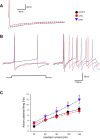Vagally mediated gastric effects of brain stem α2-adrenoceptor activation in stressed rats
- PMID: 29351390
- PMCID: PMC5966751
- DOI: 10.1152/ajpgi.00382.2017
Vagally mediated gastric effects of brain stem α2-adrenoceptor activation in stressed rats
Abstract
Chronic stress exerts vagally dependent effects to disrupt gastric motility; previous studies have shown that, among other nuclei, A2 neurons are involved in mediating these effects. Several studies have also shown robust in vitro and in vivo effects of α2-adrenoceptor agonists on vagal motoneurons. We have demonstrated previously that brainstem vagal neurocircuits undergo remodeling following acute stress; however, the effects following brief periods of chronic stress have not been investigated. Our aim, therefore, was to test the hypothesis that different types of chronic stress influence gastric tone and motility by inducing plasticity in the response of vagal neurocircuits to α2-adrenoreceptor agonists. In rats that underwent 5 days of either homotypic or heterotypic stress loading, we applied the α2-adrenoceptor agonist, UK14304, either by in vitro brainstem perfusion to examine its ability to modulate GABAergic synaptic inputs to vagal motoneurons or in vivo brainstem microinjection to observe actions to modulate antral tone and motility. In neurons from naïve rats, GABAergic currents were unresponsive to exogenous application of UK14304. In contrast, GABAergic currents were inhibited by UK14304 in all neurons from homotypic and, in a subpopulation of neurons, heterotypic stressed rats. In control rats, UK14304 microinjection inhibited gastric tone and motility via withdrawal of vagal cholinergic tone; in heterotypic stressed rats, the larger inhibition of antrum tone was due to a concomitant activation of peripheral nonadrenergic, noncholinergic pathways. These data suggest that stress induces plasticity in brainstem vagal neurocircuits, leading to an upregulation of α2-mediated responses. NEW & NOTEWORTHY Catecholaminergic neurons of the A2 area play a relevant role in stress-related dysfunction of the gastric antrum. Brief periods of chronic stress load induce plastic changes in the actions of adrenoceptors on vagal brainstem neurocircuits.
Keywords: catecholamines; neurogastroenterology; stomach; stress; vagus.
Figures






Similar articles
-
Stress-induced neuroplasticity in the gastric response to brainstem oxytocin in male rats.Am J Physiol Gastrointest Liver Physiol. 2022 May 1;322(5):G513-G522. doi: 10.1152/ajpgi.00347.2021. Epub 2022 Feb 16. Am J Physiol Gastrointest Liver Physiol. 2022. PMID: 35170350 Free PMC article.
-
Altered gastric tone and motility response to brain-stem dopamine in a rat model of parkinsonism.Am J Physiol Gastrointest Liver Physiol. 2019 Jul 1;317(1):G1-G7. doi: 10.1152/ajpgi.00076.2019. Epub 2019 May 1. Am J Physiol Gastrointest Liver Physiol. 2019. PMID: 31042398 Free PMC article.
-
Plasticity in the brainstem vagal circuits controlling gastric motor function triggered by corticotropin releasing factor.J Physiol. 2014 Oct 15;592(20):4591-605. doi: 10.1113/jphysiol.2014.278192. Epub 2014 Aug 15. J Physiol. 2014. PMID: 25128570 Free PMC article.
-
Vagal neurocircuitry and its influence on gastric motility.Nat Rev Gastroenterol Hepatol. 2016 Jul;13(7):389-401. doi: 10.1038/nrgastro.2016.76. Epub 2016 May 25. Nat Rev Gastroenterol Hepatol. 2016. PMID: 27251213 Free PMC article. Review.
-
Role of brainstem TRH/TRH-R1 receptors in the vagal gastric cholinergic response to various stimuli including sham-feeding.Auton Neurosci. 2006 Apr 30;125(1-2):42-52. doi: 10.1016/j.autneu.2006.01.014. Epub 2006 Mar 6. Auton Neurosci. 2006. PMID: 16520096 Free PMC article. Review.
Cited by
-
Hypothalamic-vagal oxytocinergic neurocircuitry modulates gastric emptying and motility following stress.J Physiol. 2020 Nov;598(21):4941-4955. doi: 10.1113/JP280023. Epub 2020 Sep 7. J Physiol. 2020. PMID: 32864736 Free PMC article.
-
Stress Adaptation Upregulates Oxytocin within Hypothalamo-Vagal Neurocircuits.Neuroscience. 2018 Oct 15;390:198-205. doi: 10.1016/j.neuroscience.2018.08.021. Epub 2018 Aug 31. Neuroscience. 2018. PMID: 30176320 Free PMC article.
-
Novel transmitters in brain stem vagal neurocircuitry: new players on the pitch.Am J Physiol Gastrointest Liver Physiol. 2018 Jul 1;315(1):G20-G26. doi: 10.1152/ajpgi.00059.2018. Epub 2018 Mar 29. Am J Physiol Gastrointest Liver Physiol. 2018. PMID: 29597355 Free PMC article. Review.
-
Central control of gastrointestinal motility.Curr Opin Endocrinol Diabetes Obes. 2019 Feb;26(1):11-16. doi: 10.1097/MED.0000000000000449. Curr Opin Endocrinol Diabetes Obes. 2019. PMID: 30418187 Free PMC article. Review.
-
Role of estrogen and stress on the brain-gut axis.Am J Physiol Gastrointest Liver Physiol. 2019 Aug 1;317(2):G203-G209. doi: 10.1152/ajpgi.00144.2019. Epub 2019 Jun 26. Am J Physiol Gastrointest Liver Physiol. 2019. PMID: 31241977 Free PMC article. Review.
References
Publication types
MeSH terms
Substances
Grants and funding
LinkOut - more resources
Full Text Sources
Other Literature Sources

